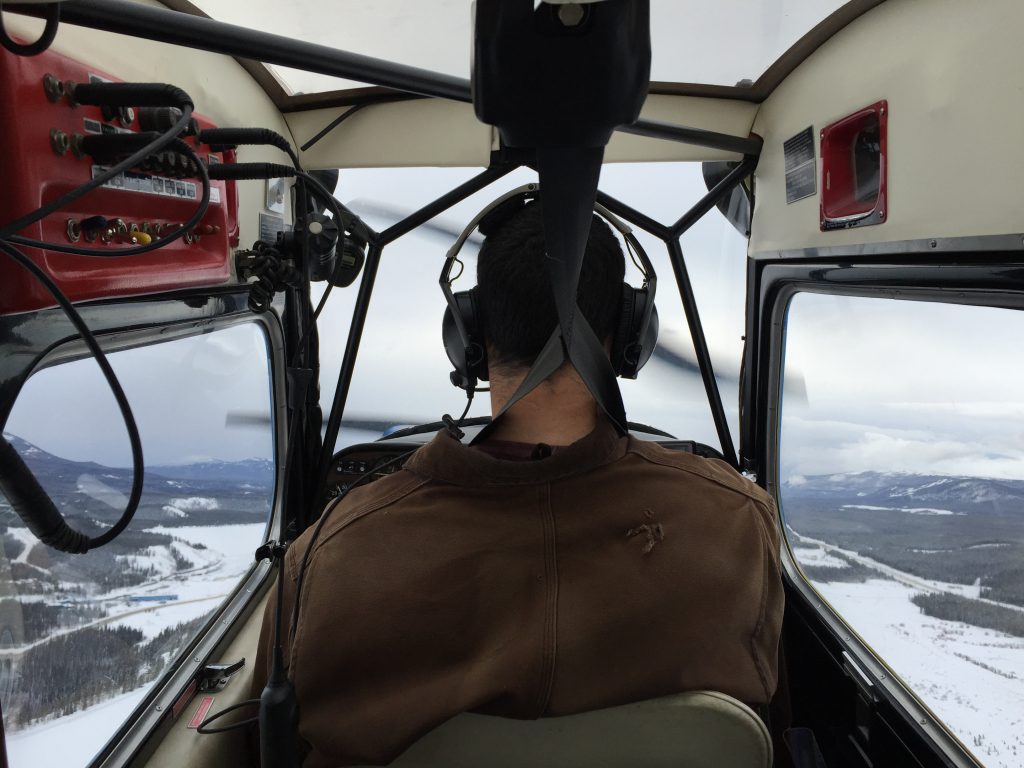
The view from my seat.
CLASS 4 INSTRUCTOR RATING COURSE
The Class 4 Instructor Rating is one of the more common routes to your first job. It is added to your Commercial Pilot Licence and allows you to teach flying while working under supervision at a flying school. You cannot freelance or work without supervision until you accumulate enough experience to upgrade to a Class 3 rating.
It is said that the instructor rating course is where you learn what you should have known all along. In this course your flying skills and aeronautical knowledge will be polished to a high level.
In addition, you will learn to teach, both on the ground and in the air. At first, flying and teaching at the same time will leave you feeling like you can do neither. By the end of the course you will be able to fly and teach confidently from the right seat, and teach comfortably in a one-on-one classroom situation. This will be accomplished largely by:
1) preparation,
2) practice, and
3) role-playing.
Preparation and practice of ground and air lessons will be done at largely at home. You will likely spend about 4 hours of prep and practice at home for every flight or ground instruction session at the flight school. (This means a total time commitment of approximately 300 hours, not merely the 25 hours of groundschool and 30 hours of flight time required.) Practice should be done on willing victims (need not be pilots) as this makes the practice more realistic and relevant. Your work at home will be directed and reviewed by your instructor. You must allow sufficient time between flights and ground sessions to adequately prepare. Research and development (R and D) will be done in the background, by you, at home.
Role-playing is done between you and your instructor. You will be assuming the role of an instructor, a student pilot, or yourself. Your instructor will be assuming the role of a class 1 instructor teaching an instructor trainee, a class 4 instructor teaching a student pilot, a student pilot, or himself. In the role of a student pilot, he will generally be an average student, but will often be a poor or cantankerous student. He will try to lead you off-topic, frustrate you and cause you to lose control of the situation. He will also probe the limits of your knowledge by asking a lot of “why” questions and claiming not to understand your explanations. You must be prepared to back up anything that you say with knowledge and references.
In presenting your lessons, you will frequently start, stop, rewind and start again. You may repeat the same small section of a lesson several times. There will be frequent “time-outs” when you will get out of character for a few moments to discuss theory, technique or delivery. Be prepared to take notes in the classroom and in the airplane.
Before commencing training for the Instructor Rating, you must possess a Commercial Pilot Licence or higher, and have a valid Category 1 Medical Certificate. Prior to commencing training, you must be able to fly all private and commercial flight test exercises to a score of 3 or 4, and possess a level of knowledge equivalent to that required for the issue of the Commercial Pilot Licence. I will assess your knowledge and skills by means of a check flight and written exam.
In addition to the above prerequisites, the course requirements are as follows: You must complete a minimum of 30 hours of dual instruction and 25 hours of ground training with a Class 1 flight instructor. (I find that 35 and 30 hours respectively is more realistic.) You must then demonstrate your knowledge by obtaining not less than 70% on the final written exam, and demonstrate your skill by passing a flight test with a Transport Canada examiner. The written exam must be passed before the flight test is attempted. Studying for the written exam will be done largely in the background, by you at home. You will be given assignments and sample exams to help you prepare.
You will need to obtain the following publications and references:
Flight Test Guide, Flight Instructor Rating
Study and Reference Guide, Flight Instructor Rating
Aeronautical Information Manual
Flight Training Manual, TP1102
Pilot Operating Handbook or Flight Manual for your aircraft.
Human Factors for Aviation, Basic Handbook, TP12863
Human Factors for Aviation, Advanced Handbook, TP12864
Human Factors for Aviation, Instructor’s Guide, TP12865
Advanced Pilot’s Flight Manual, Bill Kerschner
From The Ground Up
Please note that I generally will not “finish up” a student who has done some work with another class 1. All class 1 instructors work differently, and inheriting a student from another class 1 is problematic. Think of it this way: PPL and CPL students are construction projects. Put all the parts together correctly and, presto, you have a pilot. Instructor rating candidates on the other hand are works of art, carefully crafted from raw materials, each one unique. You wouldn’t finish off someone else’s symphony, would you?
